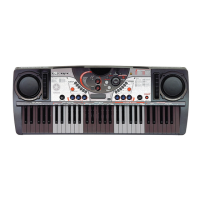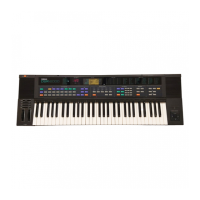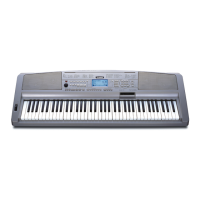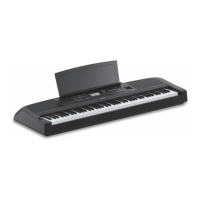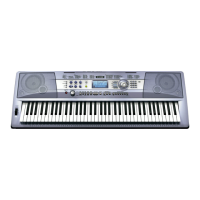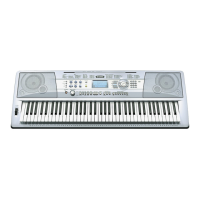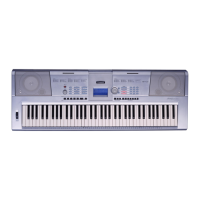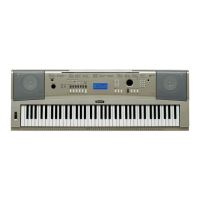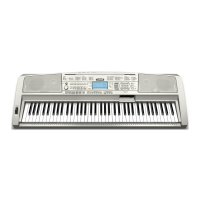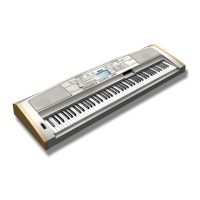How to eliminate humming sound from Yamaha DJX?
- KKendra DunlapSep 13, 2025
Make sure that the power adaptor is not close to or resting on the Yamaha Electronic Keyboard panel.
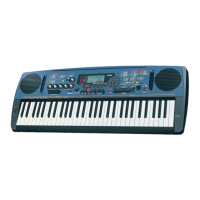
How to eliminate humming sound from Yamaha DJX?
Make sure that the power adaptor is not close to or resting on the Yamaha Electronic Keyboard panel.
| Number of Keys | 61 |
|---|---|
| Polyphony | 32 notes |
| Arpeggiator | Yes |
| Display | LCD |
| Sound Engine | AWM (Advanced Wave Memory) |
| Styles | 100 |
| Sequencer | Yes |
| MIDI | In, Out |
| Songs | 5 |
| Connectivity | MIDI In/Out |
| Speakers | Yes |
| Effects | Reverb, Chorus, DSP |
Important information and warnings regarding battery usage and disposal.
Guidelines for the proper disposal of damaged or end-of-life products.
Information on where to find the product's name plate for serial numbers.
Essential safety warnings to prevent serious injury or death from electrical hazards.
Basic precautions to avoid physical injury or damage to the instrument or property.
Recommendations for backing up important data to prevent loss due to malfunctions.
Description of controls allowing dynamic, real-time changes to sound and patterns.
Functionality for recording and playing back custom sounds from the keyboard.
Overview of the DJX keyboard's front panel controls and buttons.
Information on power sources, including AC adaptor and battery operation.
Instructions for powering the DJX instrument on and off correctly.
A step-by-step introduction to operating the DJX for immediate play and exploration.
Explains the purpose of different key sections like Part Select, Part On/Off, Pattern, and Performance.
Details about the default demo voice that plays automatically upon powering on the DJX.
Instructions on how to play the three built-in demo songs showcasing instrument sounds and patterns.
Guide to choosing from the DJX's extensive library of 284 voices, including panel and GM voices.
Guide on connecting sources and entering the sampling mode for recording sounds.
Detailed instructions on how to select and change various DJX settings via the Function mode.
How to assign functions to the ASSIGN knob and RIBBON CONTROLLER for customized control.
How to play a single voice across the entire keyboard range.
Technique for layering two voices together for richer, complex sounds.
Method for setting up two different voices for separate keyboard sections.
Explanation of the two voice sets and the use of General MIDI voices for compatibility.
List of available Drum Kit voices and their corresponding keyboard assignments.
Adjusting the keyboard's pitch to match other instruments or change the song's key.
How to activate the Dual Voice mode to layer two different sounds together.
How to activate the Split Voice mode to assign different sounds to keyboard sections.
Explains parameters affecting voice selection, playing dynamics, and pitch bend wheel range.
How to turn on and set the Reverb effect type and send level for enhanced sound.
Instructions for activating Chorus effect, setting type, and adjusting send levels for richer sound.
Details on activating DSP effects, selecting types, and adjusting send levels for sound modification.
Guide to activating the Arpeggiator, setting its type, and controlling speed for automatic patterns.
A comprehensive list of effect parameters and their corresponding functions and page references.
Lists detailing the available types for Reverb, Chorus, and DSP effects.
Steps to select and start playback of demo or user songs on the DJX.
How to adjust the playback speed (tempo) for songs.
Explanation of the beat indicators in the display for rhythm and tempo visualization.
How to control the playback volume specifically for songs.
Guide to choosing music styles and starting pattern playback on the DJX.
How to use the Lead In section to start patterns with an intro.
Function to start patterns by pressing any keyboard key.
Explanation of panel buttons that control pattern playback functions like Start/Stop and Beat selection.
Details on the different sections that make up a musical style pattern.
Instructions on adjusting the tempo for patterns, similar to song tempo.
How to control the playback volume specifically for patterns.
Feature to break up patterns with stuttering effects and reset the pattern to the measure start.
Function to mute or unmute individual instrument parts of a pattern in real-time.
Explanation of how instruments and sounds vary across different pattern parts and styles.
Details on the Function parameter for setting the highest key for the pattern section.
How to save and recall custom instrument settings using User banks.
Steps to load previously saved User Performance Setups for instant recall.
How to choose different banks to access saved User Performance Setups.
How to select factory-programmed setups that match specific styles for optimal sound.
Guide on using the five control knobs for real-time sound manipulation of voices and patterns.
Details on the functions of the Cutoff, Resonance, Groove, Assign, and Bass Boost knobs.
Explains how the Cutoff and Resonance filter controls affect the sound of the instrument.
Details on the Groove control and its effect on the rhythmic feel of patterns.
How to select and assign functions to the ASSIGN knob for flexible control.
A list and explanation of parameters that can be controlled by the ASSIGN knob.
Guide on how to use the Ribbon Controller for expressive sound changes.
A list and explanation of parameters that can be controlled by the Ribbon Controller.
Explanation of the Ribbon Controller's operation and its relation to the knobs.
Introduction to the concept of digital sampling and its use in creating music.
Step-by-step instructions for recording, setting levels, and playing back sampled sounds.
Tips and best practices for recording high-quality samples, including connections and levels.
Explanation of the trigger level setting for controlling sample recording start points.
Information on the available memory for samples and recording time limits.
How to remove unwanted recorded samples from memory.
Instructions for recording multiple samples on different keyboard keys.
How to adjust the playback duration of a recorded sample.
How to adjust the playback duration of a recorded sample.
How to set up recorded samples to play back repeatedly as loops.
Explanation of the different resolutions (Coarse, Mid, Fine) used for sample editing.
Method for recording performances in real time, similar to a tape recorder.
Method for entering notes and chords individually for precise control over recordings.
Step-by-step guide to recording songs using the Realtime method.
How to record pattern data and chords using the dedicated Chord track.
How to selectively mute tracks during recording or playback for clarity.
Steps to overwrite a previously recorded track with new performance data.
Method to erase a single melody track without affecting the entire song.
Detailed instructions on entering notes, chords, and rests for Step recording.
How to record chords and pattern sections into the Chord track.
Techniques for entering special note durations like triplets and dotted notes.
How to insert rests into song recordings, including dotted and triplet rests.
An introduction to MIDI technology and its application in electronic musical instruments.
Illustrates the types of data transmitted via MIDI, such as note, velocity, and control change.
How to connect the DJX to a computer for expanded musical possibilities using MIDI.
Description of the DJX's MIDI IN and OUT terminals for data exchange.
Determines if the keyboard's internal voices respond to MIDI data or keyboard input.
Controls whether style and song playback are synchronized with external MIDI clock data.
Function to save DJX settings and user data to an external device.
Transmits DJX initial setup settings to a sequencer for song playback.
Saves user-sampled data from the 'Sampled' voice to an external device.
How to reset the DJX to factory presets to restore normal operation or recover from errors.
Information on the maximum number of notes the DJX can play simultaneously.
A detailed list of panel voices, including bank select and MIDI program change numbers.
A list of General MIDI voices available on the DJX, with corresponding numbers for MIDI playback.
A table detailing the DJX's special drum kits, including keyboard mapping and MIDI note assignments.
A chart detailing the mapping of MIDI messages to effect types for Reverb, Chorus, and DSP.
Outlines the responsibilities of the user when seeking warranty service for the product.
Details circumstances and conditions not covered by the product's warranty.
